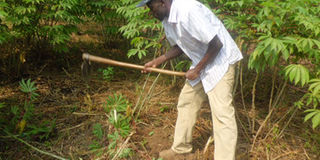Stocking cassava for the future

Improved cassava known as Nase in a garden. An initiative by Ugandan scientists aims at documenting all varieties that are being grown in the country. PHOTO BY LOMINDA AFEDRARU.
There are different crop species in Africa and, particularly Uganda, which need to be preserved for future farm use. These include various legumes such as beans, cow pea, groundnuts, cereals like rice and maize, and root crops such as sweet potatoes, cassava, Irish potatoes, as well as fruits and vegetables among others.
Plant Genetic Resources Centre (PGRC) in Entebbe is already preserving a number of these crops in laboratories and the botanical garden. In the same vein, National Crop Resources Research Institute (NaCRRI) is collecting various cassava varieties to be preserved in Namulonge.
Domestic and wild
The initiative is to ensure that crop varieties, which are likely to get extinct, are kept for future regeneration. John Mulumba Wasswa, the in-charge of the gene bank at PGRC, in an earlier interview, said his team is preserving both domestic crops and their wild species. The former would be readily accessible to farmers who want to plant them and the latter made available to scientists contacting trials to improve different crop varieties against diseases and pests, for increased yields and counter climate change challenges like drought and floods.
“We keep traditional crop varieties grown country wide as well as wild species such as wild finger millet, coffee, sorghum and the green vegetable commonly known as nakkati,” he explained. “Sometimes we keep the genes of some crops in a refrigerator and in form of seeds, which can last more than 50 years without damage.
The wild species contain genes that can be used to improve indigenous crops. It is also a requirement for countries to contribute to an international gene bank based in Colombia. Here, Uganda is represented by finger millet and sorghum.
However, scientists at Namulonge are conserving local varieties farmers have been growing including those have sterile seeds and those that do not. Dr Grace Nakabonge heads the team that is collecting cassava varieties mainly from the cassava-growing area in Uganda under Eastern Africa Agricultural Productivity (EAAP) project. The initiative is to boost the breeding process and to rescue varieties being wiped out by pests and disease.
Knowledge and methods
The team relies on farmers’ knowledge about the varieties in the different places they have so far gone to. These include Arua, Koboko and Nebbi districts where varieties such as Basumenge, Kali, Mabulu, Abiria, Jeyo, Nyaraboke, Bali and Nyapamitu, among others, are found. Buliisa and Kiryandogo, where mainly Bukalasa is grown as well as Masindi and Hoima.
They intend to go to all districts where cassava is grown on a large scale such as Lira in the north and in the east and west. Dr Nakabonge says her team preserves the cassava germplasm using two methods.
One is ex situ conservation where plantlets bred through tissue culture are kept frozen in test tubes via what is known as cyro-preservation technique.
The other method is in situ perseveration where they are conserved in a confined field using a method known as Bonsai collection. Here the plantlets are kept in small sizes and grown in restricted places. In both, what is conserved is pest and disease free.
Document all varieties
The team will also create a data base on the characteristics. To achieve its objective, there is need for thermotherapy capacity as well as laboratory consumables to conserve these materials which is apparently a challenge.
There has been little record of how many cassava varieties farmers in Uganda are growing apart from the improved varieties, such as the Nase series. This initiative will be the first of its kind to document all cassava species that exists in the country. John Odipio, a cassava breeder at Namulonge, says there are 19 improved varieties that have been released to farmers since 2007.
Since that year, 12 varieties namely Nase1 to Nase12 were released. Last year, Nase14 to Nase19 were released with most farmers mainly concentrating in growing Nase14 because of its good qualities.




